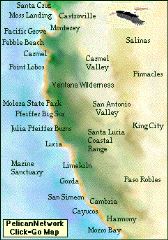|
|
|||||||||||
Salinans thrived in the San Antonio Valley. At the time of the Europeans arrival in 1769, there were about 3,000 Salinans living in San Antonio Valley. They conducted agriculture, traded commercially with coastal tribes and populations in the Central Valley. |
||||||||||||
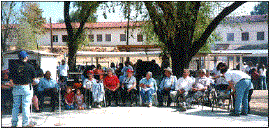 |
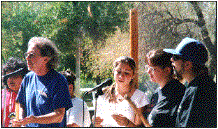 |
Salinan Nation gathers annually at Mission San Antonio. Above left, Gregg Castro, one of the Nation’s leaders addresses a group of elders who were being honored at the Gathering. Above right, Jose Freeman leads a group singing authentic ancient Salinan songs. Below left, a woman at the Gathering is in thought. Bottom right, a group of the event’s planners tell stories for a visitor. |
|
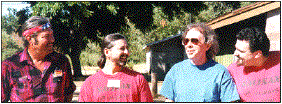
Robert Duckworth, Gregg Castro, Jose Freeman and Ken Castro
Spain’s Colonial economic system
depended on Indian labor. History of that era has been
romantized. Recently, however, more realistic accounts are
being recorded. Here is an account in Tending the Wild
by Dr. Kat Anderson: “Mission Indians labored long and
hard, often lived under miserable conditions had poor diets,
suffered from epidemics, experienced physical abuse and
intimidation, and died in huge numbers. After the
establishment of the missions, diseases such as syphilis,
tuberculosis, dysentery, diphtheria, and measeles spread
rapidly throughout native popuilations lacking any immunity,
aided by crowded living condiions in drafty adobe
dormitories with poor sanitation. Deficient diets consisting
of a starchy cereal soup and a little meat predisposed
Indians to infectious disease and malnutrition. Medical
treatment was rare. “In an 1813 report on Mission San
Antonio de Padua, Father Señàn noted that ‘for
each two (Indians) that are born three die.’ Mission records
show an even more morbid relationship: between1799 and 1833
the padres recorded 62,000 deaths and only 29,000 births. At
its height, the mission system boasted a total of 72,000
Indian converts, or neophytes, but by 1830 only 18,000
neophytes remained. The total loss of the mission Indian
population has been estimated, on the basis of mission
reords, at 72 percent. The anthropologist Aolfred Kroeber
wrote, ‘It must have caused many of the Fathers a severe
pang to realize, as they could not but do daily, that they
were saving souls only at the inevitable cost of lives. And
yet such was the overwhelming fact. The brute upshot of
missionization, in spite of its kindly flavor and
humanitarian root, was only one thing, death.'”
For six thousand years they existed
peacefully with other Indians. However, in the 1770’s,
contact with Europeans brought violent subjugation.
During the short rule of California by the Mexicans,
the Salinans were amongst those native people who
fared relatively well, but when Americans took control
of California, execution, and enslavement became
normal. To avoid this almost certain fate, some
mothers actually took their newborn children to the
Ventana back country and abandoned them.
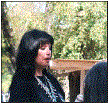
Salinan
people learned to hide from the Europeans
who quickly dominated California.
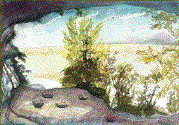
Wagon
Cave – a watercolor by Marilyn Sabold. Click the
image to see a larger version.
Others
just disappeared by themselves. A typical story
is that of a University of California
anthropologist coming to a popular meeting place
in Jolon and asking if anyone knew where he
could find any Jolon or Salinan (the same
people, actually) Indians. Each person there,
all of whom were Jolon-Salinan Indians, shook
their heads, “No, don’t know.”
Salinans
kept their culture alive by telling stories in their
families. Now they are becoming more outspoken to the
outside world in order to enlighten others about their
valuable cultural
legacy.
Are
you interested in the Salinan Nation? Give us your
feedback/input. Please send us this
form:



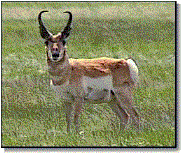

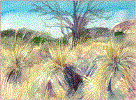

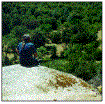
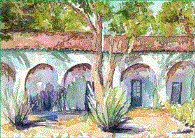
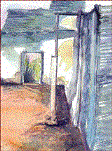



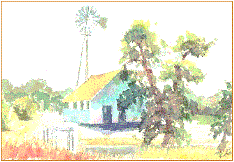

 PelicanNetwork
is a cultural and natural history information advocacy
and
PelicanNetwork
is a cultural and natural history information advocacy
and
